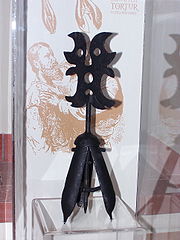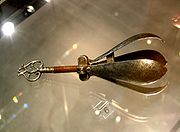
Choke pear (torture)
Encyclopedia

Pear
The pear is any of several tree species of genus Pyrus and also the name of the pomaceous fruit of these trees. Several species of pear are valued by humans for their edible fruit, but the fruit of other species is small, hard, and astringent....
-shaped) divided into spoon-like segments that could be spread apart by turning a screw. The museum descriptions and some recent sources assert that the devices were used either as a gag
Gag
A gag is usually a device designed to prevent speech, often as a restraint device to stop the subject from calling for help. This is usually done by blocking the mouth, partially or completely, or attempting to prevent the tongue, lips, or jaw from moving in the normal patterns of speech. They are...
, to prevent people from speaking, or as an instrument of torture
Torture
Torture is the act of inflicting severe pain as a means of punishment, revenge, forcing information or a confession, or simply as an act of cruelty. Throughout history, torture has often been used as a method of political re-education, interrogation, punishment, and coercion...
. The instrument was inserted into the victim's mouth, and then slowly spread apart as the screw was turned.
Origins

Further mentions of the device appear in the 19th century. They are also mentioned in Grose
Francis Grose
Francis Grose was an English antiquary, draughtsman, and lexicographer. He was born at his father's house in Broad Street, St-Peter-le-Poer, London, son of a Swiss immigrant and jeweller, Francis Jacob Grose , and his wife, Anne , daughter of Thomas Bennett of Greenford in Middlesex...
's Dictionary of the Vulgar Tongue (1811) as "Choak Pears," and described as being "formerly used in Holland."
They were also discussed in a book by Eldridge and Watts, superintendent of police and chief inspector of the detective bureau in Boston, Massachusetts (1897). While accepting that ordinary pear-shaped gags exist, they observed that contemporary robbers used no such device as Palioly's Pear and cast doubt upon its very existence in the first place, saying that "fortunately for us this 'diabolical invention' appears to be one of the lost arts, if, indeed, it ever existed outside of de Calvi's head. There is no doubt, however, of the fashioning of a pear-shaped gag which has been largely used in former days by robbers in Europe, and may still be employed to some extent. This is also known as the 'choke-pear', though it is far less marvellous and dangerous than the pear of Palioly."
Another mention is found in Brewer's Dictionary of Phrase and Fable
Brewer's Dictionary of Phrase and Fable
Brewer's Dictionary of Phrase and Fable, sometimes referred to simply as Brewer's, is a reference work containing definitions and explanations of many famous phrases, allusions and figures, whether historical or mythical.-History:...
(1898) claims that "Robbers in Holland at one time made use of a piece of iron in the shape of a pear, which they forced into the mouth of their victim. On turning a key, a number of springs thrust forth points of iron in all directions, so that the instrument of torture could never be taken out except by means of the key."
Museum pieces
Though there is little or no evidence of its being used by bandits, there are a number of extant examples of ornate and elaborate, pear-shaped devices with three or four leaves or lobes, driven by turning a key that rotates the central screw thread, which spreads the leaves. These are generally held in museums devoted to the subject of torture, and are described as instruments of torture by distension or evisceration. Some, but not all, have small spikes of uncertain purpose at the bottom of each leaf. However, these devices do not seem to match the descriptions given by Calvi or the 19th century sources.This version of the pear has also been referred to as the "Pear of Confession", the "Pope's Pear" (these due to reports that such devices were used during the Inquisition); the "oral pear", "vaginal pear", or "anal pear"; and just "The Pear".
See also
- Choke pear (plant)Choke pear (plant)A choke pear or chocky-pear is an astringent fruit. It is any variety of pear that has an astringent taste and that is difficult to swallow.- Varieties :...
, a hard-to-swallow fruit that may have been the origin of the instrument's name.

